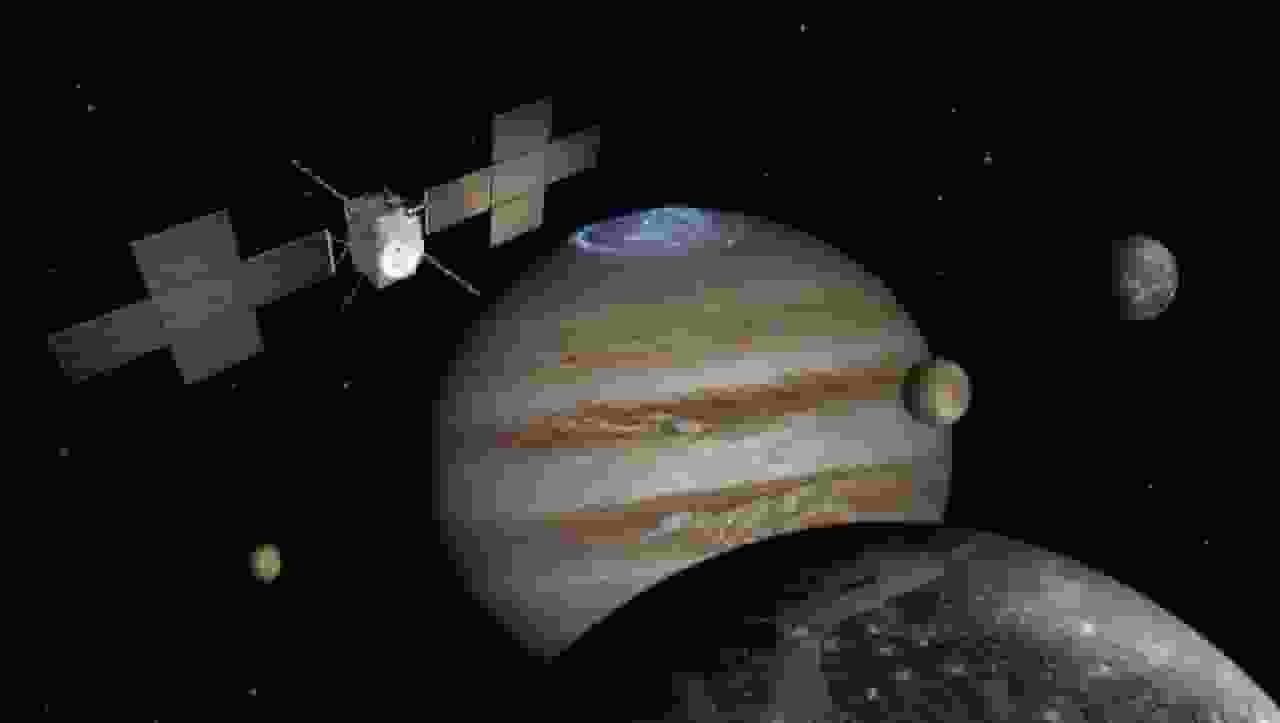For the time being, the European Space Agency’s Jupiter Icy Moons Explorer (JUICE) is returning to Earth.
JUICE completed a 43-minute burn to prepare for its forthcoming Earth-moon encounter, the first-ever double gravity assist of the two celestial bodies. The spacecraft’s biggest maneuver to yet. “This maneuver used up roughly 363 kilograms [800 pounds] of fuel—or almost exactly 10% of the 3,650 kilograms [8,047 pounds] of fuel that JUICE launched with,” Julia Schwartz, Flight Dynamics Engineer at ESA’s ESOC mission control center in Germany, said in a statement.
JUICE is a European Space Agency (ESA) mission that will examine Jupiter and three of its ice moons: Europa, Callisto, and Ganymede.
JUICE, a single orbital spacecraft with no lander, will orbit Ganymede, the biggest moon in the solar system, becoming the first probe to orbit a planetary moon other than Earth’s.
JUICE successfully launched at 8:14 a.m. on April 14, 2023. EDT (1214 GMT) from Kourou, French Guiana’s Spaceport. But be patient; it will take nearly eight years to reach the solar system’s biggest planet.
The spacecraft launched from French Guiana on April 23, 2023, with the goal of studying Jupiter and three of its frozen, possibly oceanic moons: Ganymede, Callisto, and Europa. However, in order to get there, it must fly past the planets of the inner solar system and use their gravitational tides to slingshot itself toward its destination—a tactic that saves total fuel.
This burn is one of two required to place JUICE on the correct course for the Earth-moon gravity assist, the first of a series of assistance scheduled for August 2024. “This first burn did 95% of the work, changing JUICE’s velocity by almost 200 meters per second [656 feet per second],” Schwartz said. “JUICE is one of the heaviest interplanetary spacecraft ever launched, with a total mass of around 6,000 kilograms [13,228 pounds], so it took a lot of force and a lot of fuel to achieve this.”
ESA will examine JUICE’s new orbit in the next few weeks before calibrating a second fire to fine-tune the probe’s course for the double gravity assist. “If both parts of this maneuver go well, we won’t need to use the main engine again until we enter orbit around Jupiter in 2031,” JUICE Spacecraft Operations Manager Ignacio Tanco stated in a statement. “For small trajectory corrections between now and then, we will use JUICE’s smaller thrusters.”
This initial burn was especially difficult since sections of it couldn’t be checked ahead of time.
“For example, we only had an estimate for how the liquid in the fuel tanks will move around as the spacecraft accelerates,” Tanco went on to say. “This is very important to know precisely, because if the fuel behaves differently than we expect, it could cause the spacecraft to drift off course during the burn. So, we are monitoring closely.”
The data from this burn will be used to influence subsequent burns for JUICE’s Jupiter insertion, when the probe will need to slow down by around one kilometer per second (0.62 miles per second) to finally join Jovian orbit.
For the time being, we’re just waiting to see if Juice will return.
Why did scientists say it will take 8 years for JUICE to arrive on Jupiter?
Jupiter circles Earth at a distance of around 444 million miles (715 million kilometers), so getting to the huge planet is certainly more than a hop, skip, and jump. However, several spacecraft have traveled from Earth to Jupiter far faster than JUICE.
As it turns out, whether a spacecraft will pass past Jupiter or enter orbit for a reasonably long-term mission is one of the key factors influencing the trip time to Jupiter.
NASA’s Pioneer 10, which launched on March 3, 1972, and performed its flyby of Jupiter on December 3, 1973, was the first spacecraft to travel from Earth to Jupiter in 640 days. Pioneer 11’s flyby course was even quicker, hitting Jupiter in just 606 days.
The orbiters, on the other hand, must be more methodical than flyby vehicles because they must travel slowly enough at the conclusion of their mission to be trapped by Jupiter’s gravity. JUICE will travel across outer space for eight years. The Galileo probe, launched in October 1989 and arriving in orbit in December 1995, took almost six years to go to Jupiter. Juno, the agency’s spacecraft, launched in August 2011 and arrived in July 2016.
The mission “will do a complex sequence of gravity assist maneuvers, starting one year after launch, taking moon and Earth gravity assists, both bodies at the same time, to get the extra energy,” according to ESA scientist Alessandro Atzei during a JUICE press event on April 6. “And then we have a Venus flyby gravity assist [and] two more Earth gravity assists in 2026 and 2029 to arrive at Jupiter in the distant July of 2031.”
However, JUICE’s use of gravity aids will not end there. Even when it begins its scientific mission, the spacecraft will require gravitational assistance to reach Ganymede, Europa, and Callisto. (JUICE will first orbit Jupiter, completing several flybys of all three moons, before shifting to Ganymede in 2035, becoming the first probe to orbit a moon other than Earth’s.)
“The gravity assists have to be precise, but we have very capable people in the Mission Control Unit, and they’re accustomed to these maneuvers,” he said.




![Tyson Foods Plant [Photo: Food Manufacturing]](https://southarkansassun.com/wp-content/uploads/2023/08/iStock_1185520857__1_.5e441daa51cca-600x337.jpg)








![Silverado Senior Living Management Inc. [Photo: Los Angeles Times]](https://southarkansassun.com/wp-content/uploads/2023/10/download-6-4-600x337.jpg)

![China's Wuhan Institute of Virology [Photo: Nature]](https://southarkansassun.com/wp-content/uploads/2023/09/d41586-021-01529-3_19239608-600x337.jpg)















